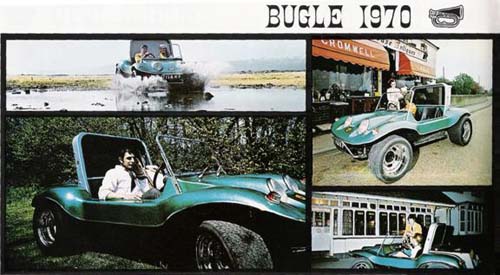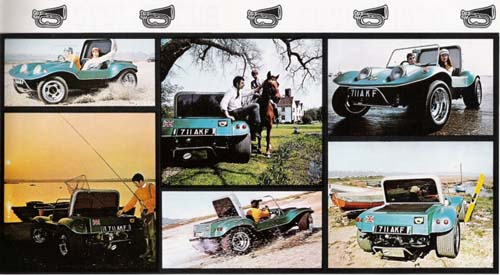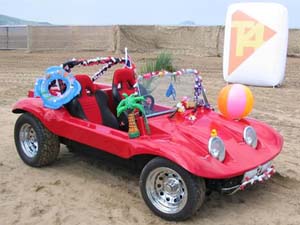

As the swinging sixties came to an end it left behind a generation of rich and famous celebrities with a passion for contemporary style. Keen eyed entrepreneur Roland Sharman spotted an opportunity to supply this market with trend setting luxury beach buggies based on the GP buggy kit. Roland formed The Sharman Drag Co. Ltd. and produced fully built cars with a sumptuous level of trim which were sold under the name of Bugle Buggies. Unlike the majority of self-built buggies, the Bugle came with a fully carpeted and trimmed interior and a softtop roof. The Bugle was a buggy intended for cruising the Kings Road rather than thrashing over sand dunes. Why was it called a Bugle? When the first prototype was assembled Sharman's wife said "the exhausts look like bugles why not call it a bugle buggy?"


The thinking behind the new Bugle was to provide a Beach (as opposed to Dune) buggy more appropriate for Europe rather than simply continue producing a luxury built version of the Meyers inspired GP. The Bugle was based on a VW beetle chassis shortened by sixteen inches and was to use beetle running gear throughout.
The characterisitc inboard headlamps moulded into the front of the car define the Bugle very clearly from most other buggies. It produces a "fun" look to the car and gives it a "face" reminiscent of its Beetle-based lineage and while aesthetically this made for a popular buggy that wasn't the original purpose. A beach buggy, it was invisaged, would be used to cruise along flat terrain whereas a dune buggy was a lower speed drive on more undulating sand. The shape allowed the re-use of the beetle headlights primarily to give better aerodynamics for the intended higher speed use.
Another distinctive Bugle feature is the roll bar and rear screen. Sharman wanted to remove the need for a framework for the roof of a buggy and settled on a design that disguised the rollbar and made provision for a rear screen made of smoked Plexiglass. This made for easy fitting of a soft top roof and side screens and combined with a subtle raised area running along the side of the cockpit allowing water to drain away form the interior. The design kept the buggy dry inside even in the infamous Britsh climate.
Sharman always thought buggies looked terrible with skinny wheels so one of the design criteria was to make the wings so wide it forced the use of wide rimmed wheels. This worked and Roland says he never saw a Bugle with anything other than a 10" rear 7" front combination.
The body was designed to be moulded in one piece. A full size clay plug was created and the original Bugle mould was taken from it. The bodies were made with a heavy layup of fibreglass keeping body flexing to a minimum.
Two from the early run of Bugles were produced much lighter as special projects, both were silver with a gold stripe, drastically lowered with only four inches ground clearance and designed purely for road use. They were each fitted with a wrap around perspex screen only ten inches high, a disc brake conversion and a Porsche 6 cylinder engine. Sharman recalls "0-60 about the same as a Cobra, we got one over 120mph and it was scary as hell, only did that once, but for very quick road use up to 100mph they were a total blast."
 The intention from the outset was to create a buggy business that was a cut above the others, heavily funded and producing a high quality body accompanied by high quality promotion material. Sharman ran full page full colour adverts in the motoring press, often the outside back cover space at premium costs. Intensive branding and marketing followed with tshirts, keyrings and decals on all products. The promotional picture of the Bugle with the Harley Davidson and the girl was taken in Fulham Cemetary by the same photographer who did the Pirelli calendar.
The intention from the outset was to create a buggy business that was a cut above the others, heavily funded and producing a high quality body accompanied by high quality promotion material. Sharman ran full page full colour adverts in the motoring press, often the outside back cover space at premium costs. Intensive branding and marketing followed with tshirts, keyrings and decals on all products. The promotional picture of the Bugle with the Harley Davidson and the girl was taken in Fulham Cemetary by the same photographer who did the Pirelli calendar.
The marketing paid off and the Bugle was treated seriously by the motoring press, AIrfix selected the Bugle as the "Beach Buggy" they wanted and created a very accurate construction kit and cartoon editor of Punch, Russell Brockbank one of the best car cartoonists, used a Bugle in two of his cartoons.
Lotusmere Ltd was founded and traded under the name of "The Bugle Automotive Traction and Manufacturing Company of London" with offices in the crypt of St Jude's church West London, body moulding was subcontracted out to a company in Sheerness in a range of metalflake colours. Possibly as a result of the unique styling (only the American Bugetta had remotely similar integrated headlamps), the Bugle was an instant success, and Sharman soon had to move the business to other premises (partially due to the crypt burning down) and started a manufacturing plant on an industrial estate in Reading and a fit-out shop and service centre on Battersea Bridge Road in London.
The original cars were a single unit mould with the fuel tank moulded in as part of the bodyshell between the rear bulkhead and small boot area. A fibreglass petrol tank isn't very safe so this design was soon changed and the tank was substituted for a metal tank with race car style fuel filler. The Bugle was a pure two seater configuration the sixteen inches of shortening to the beetle chassis made sure of that. The wide arched design allowed Lotusmere to become the UK agent for the highly desirable chromed slot wheels made by Rocket Wheel Industries in California.
Sales shot up when the Bugle appeared on the front cover of Motor magazine in 1970 and this prompted Sharman to develop the kit into a long wheelbase model on an unshortened beetle chassis called the Bugle Plus2 with seating for four people.
Bugle Buggies grew so popular that Volkswagen themselves took an interest in the car. VW had the idea of selling the Bugle in VW showrooms with all new parts but unfortunately a contract between the two was never signed.
Lotusmere built 850 Bugles and 20 of the long wheelbase Bugle Plus2s before the UK buggy market crashed, funding was withdrawn and the project was mothballed in 1972.
Fibresport retained three Bugle moulds and one Bugle Plus2 mould and made a few unofficial Bugles between 1972 and 1979 advertising in custom car magazines. Two of the moulds were reposessed, one of which was then purchased by Chris Watson of CW autos. Fibresports retained the long wheelbase mould and one short wheelbase mould. The long wheelbase mould as sold off, the fate of the short wheelbase mould is unknown.
CW Autos acquired the project in 1979 but very little is known about it during this time and there are no documented production figures. Chris certainly produced a few buggies, James Hale who was to become the next owner recalls seeing two of his demonstration buggies at a kit car show in the 1980s.
GT Mouldings didn't buy the moulds from Chris Watson, the Bugle disappeared for many years and two moulds were offered to James Hale by someone in the buggy world in 1995. The moulds were in a poor condition, the mould for the rear screen hoop and the rear biit lid were missing. GT Mouldings moulded two bodies cut them and made them into one based on a slightly longer chassis using only a twelve inch shortening rather than Sharman's sixteen inch cut. This change was made as the rear bulkhead of the original Bugle prevented the seats being moved back far enough to accomodate taller drivers, this also improved the handling characterisitcs over the shorter Bugle. The twelve inch cut has the added benefit of making the chassis shortening process easier as the rear chassis spine curvature is more easily aligned after cutting. The original Bugle front bulkhead moulding was also the front nose-stiffening panel that abutts the headlight bowls and didn't really fit the VW chassis very well. GT Mouldings made an entirely new front bulkhead based on a similar one from a Manta Ray buggy which correctly fits the front chassis sections, made as a separately moulded part and then bonded onto the body.
They managed to borrow an original hoop from an existing 1970's Bugle which featured the Plexiglass rear screen and alloy retaining strip along the bottom edge. This was rather complicated for the purpose and GT Mouldings made a moulded-in rear lip as part of the product. While this makes the part tight to get out of the mould in production, the benefit is the hoop design can then accomodate a glass rear screen. If an owner wished they could fit a heated rear screen, an improvement consistent with the original oppulent thinking of Sharman's Bugle concept. The Rear engine cover mounting mould was missing but they inherited a pattern and made a brand new mould for it, the bootlid pattern was cut out of MDF on a CNC cutter and a new mould made from the blank.
The other change GT Mouldings made was the the headlight bowls. Sharman's Bugle didn't have headlight bowls at all, instead the headlamp units relied on an interference fit with the body to secure them. GT Mouldings bought a pair of original beetle wings and cut the headlight bowls out of them and took moulds off the insides of these. The bowls are then moulded with a shiny gelcoat inside and a rough outside to aid keying the glassfibre matting when they are bonded to the car giving proper water protection for the lamp units.
GT Mouldings produced ten of these amended bodies under the name Bugle2 but due to the changing nature of the buggy market and the introduction of new models (most with strong reference back to the traditionally styled buggy designs the Bugle was intended to surpass) the Bugle lost out and was withdrawn. GT Mouldings were producing a number of different buggies and took the decision to concentrate on the more economically viable models and the introduction of their own GT Buggy into the market in 1997 changed their whole buggy production.
Eight complete Bugle2s still remain. Of the ten originally built one was lost when it burnt out and body number two has not been built into a car yet.
 GT Mouldings sold the Bugle project to the Armstrong brothers, Tony and Rob in June 2003 with the intention of putting the Bugle where it belongs most, back on the road.
GT Mouldings sold the Bugle project to the Armstrong brothers, Tony and Rob in June 2003 with the intention of putting the Bugle where it belongs most, back on the road.
One Bugle2 was then produced in 2005 for the Channel 4 television channel's "T4 on the Beach" event from James Hale's mould and, funding permitting, further are planned for production.
The T4 Bugle2 was built in just seven weeks with production commencing the second weekend of April 2005 after Tony Armstrong received a call from Channel 4's T4 production team asking for a buggy for the show. The show was week eight after the build started and due to the time constraints some elements of the work had to be subcontracted.
The chassis was taken to Flatlands Engineering for shortening and DA Mouldings in Essex were sub contracted to make the bodyshell in 10oz fibreglass layup. SSP were contacted to supply the wheels and running gear spares and local welder Ryan Minister fabricated strengthening plates for the steering mounts and made rollbar alterations. Michael Russ, local auto-electrician made a new wiring loom.
One of the original long wheelbase bodies has been sourced with a view to using it as a reference in creating a new mould for the long wheelbase body but stylisitcally this body looks "too long" and Tony wants to make the long wheelbase body look shorter by altering some of the rear proportions before commencing manufacture.
An original short wheelbase Bugle body has been acquired and following on from GT Mouldings advancement using the same methods, there are plans afoot to cut and modify this body for plugging a new long wheelbase Bugle possibly to be the Bugle3.
By David Howe
with contributions by Roland Sharman, James Hale and Tony Armstrong